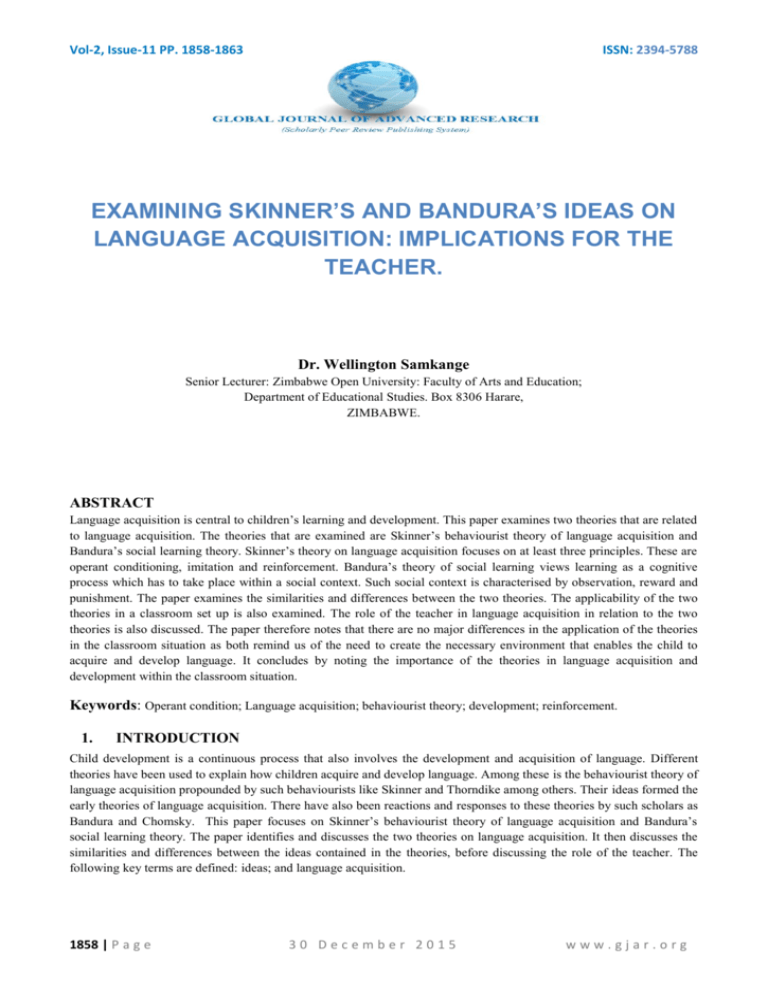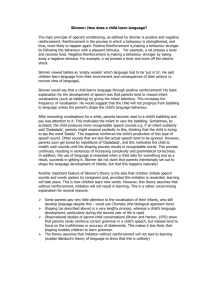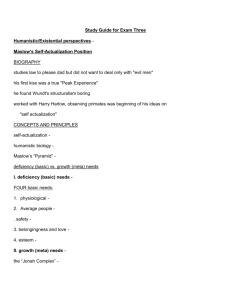examining skinner's and bandura's ideas on language acquisition
advertisement

Vol-2, Issue-11 PP. 1858-1863 ISSN: 2394-5788 EXAMINING SKINNER’S AND BANDURA’S IDEAS ON LANGUAGE ACQUISITION: IMPLICATIONS FOR THE TEACHER. Dr. Wellington Samkange Senior Lecturer: Zimbabwe Open University: Faculty of Arts and Education; Department of Educational Studies. Box 8306 Harare, ZIMBABWE. ABSTRACT Language acquisition is central to children’s learning and development. This paper examines two theories that are related to language acquisition. The theories that are examined are Skinner’s behaviourist theory of language acquisition and Bandura’s social learning theory. Skinner’s theory on language acquisition focuses on at least three principles. These are operant conditioning, imitation and reinforcement. Bandura’s theory of social learning views learning as a cognitive process which has to take place within a social context. Such social context is characterised by observation, reward and punishment. The paper examines the similarities and differences between the two theories. The applicability of the two theories in a classroom set up is also examined. The role of the teacher in language acquisition in relation to the two theories is also discussed. The paper therefore notes that there are no major differences in the application of the theories in the classroom situation as both remind us of the need to create the necessary environment that enables the child to acquire and develop language. It concludes by noting the importance of the theories in language acquisition and development within the classroom situation. Keywords: Operant condition; Language acquisition; behaviourist theory; development; reinforcement. 1. INTRODUCTION Child development is a continuous process that also involves the development and acquisition of language. Different theories have been used to explain how children acquire and develop language. Among these is the behaviourist theory of language acquisition propounded by such behaviourists like Skinner and Thorndike among others. Their ideas formed the early theories of language acquisition. There have also been reactions and responses to these theories by such scholars as Bandura and Chomsky. This paper focuses on Skinner’s behaviourist theory of language acquisition and Bandura’s social learning theory. The paper identifies and discusses the two theories on language acquisition. It then discusses the similarities and differences between the ideas contained in the theories, before discussing the role of the teacher. The following key terms are defined: ideas; and language acquisition. 1858 | P a g e 30 December 2015 www.gjar.org Vol-2, Issue-11 PP. 1858-1863 2. ISSN: 2394-5788 DEFINITION OF TERMS Ideas: Within the context of this paper the term ideas refers to theories guiding the acquisition of language. Santrock (2010) defines theory as a set of abstract, logically, coherent explanations. We are therefore concerned with the body of knowledge that seeks to explain the acquisition of language as explained by Skinner and Bandura. Language acquisition: Tomasello (2008) defines language acquisition as the process through which individuals develop the capacity to perceive, produce and use words to communicate. It is therefore the process by which people develop, retain, produce and use words to communicate. Language acquisition there involves the learning of syntax, semantics, phonetics and vocabulary. 3. SKINNERS IDEAS ON LANGUAGE ACQUISITION Skinner was one of the early behaviourist theorists. According to Weiten (2004), Skinner argued that environmental factors govern language development. Skinner, as a behaviourist emphasized the role of imitation, reinforcement and conditioning in language acquisition. For Skinner, the learning of language was similar to all the other ways children learn all other skills in life. He was concerned with the observable behaviour of organisms, guided by the operant conditioning theory. The acquisition of language is an association between the stimulus, environmental conditions and responses. Lefton (1991) notes that Skinner advocated for reinforcement. Reinforcement involves rewarding desirable behaviour. Reinforcement can be both positive and negative. In language acquisition positive reinforcement involves rewarding of correct utterances. As noted by Ambridge & Lieven (2011) when there is positive reinforcement of correct utterance the child realizes the communicative value of words and phrases. As such, when the child says “dad’’ and the caregiver smiles and gives the child some result, the feedback is rewarding to the child as it enhances the child’s language development. The reward increases the likelihood of the child repeating the action. On the other hand negative reinforcement involves withdrawing the reward when the utterances are incorrect. According to Skinner conditioning plays a role in the learning and acquiring of language as appropriate behaviour is rewarded. Operant conditioning involves reinforcement and imitation. Imitation involves copying adults’ language patterns and behaviours. Weiten (2004:312) notes that behavioural theorists like Skinner explain “how children learn syntax and learn how to construct sentences by imitating the sentences of adults and older children”. This has implications for adults such as teachers. Through imitation children are able to acquire language by making the language of the family and teacher their own. It is important that the teacher plans with the child in mind when teaching language. Since children imitate accent, usage, structure and colloquialism and other related language aspects, the role of the teacher is to ensure that children imitate language that is correct. The teacher should be well trained in the teaching of language and other areas of child development. In this case, the teacher becomes the model. Imitation helps the child in facilitating the internalisation of language. The teacher can also facilitate language acquisition by ensuring that the appropriate responses are reinforced by the correct environmental consequences and by meeting the responses and the needs of the children (Edwards, 2000). The emphasis on the environment by Skinner is of importance to the teacher, in order to facilitate development and acquisition of language. The classroom environment includes the use of games to develop language, training children in listening in order to develop listening skills and oral skills. The classroom and the school environment should help the child to develop vocabulary. This could be in the form of objects and equipment for children to learn and play with. Children play as they learn and learn as they play and the school environment should create a conducive environment. 1859 | P a g e 30 December 2015 www.gjar.org Vol-2, Issue-11 PP. 1858-1863 4. ISSN: 2394-5788 BANDURA’S IDEAS ON LANGUAGE ACQUISITION Bandura advocated for the social learning theory in language acquisition. In the social learning theory, Bandura as cited by McLeod (2011) states that in social learning theory, behaviour is learned from the environment through modelling, observation and vicarious learning. Bandura focuses on social cognitive principles of learning which also apply to the learning of language. Children pay attention to some of the people they come into contact with and imitate their behaviour through observation. In observation, language is acquired through the influence of others who are models. According to Bandura (1977), “people can learn new information and behaviours by watching other people”. When children learn, they are concerned with behaviour and its consequences. Bandura (1977) notes that apart from observation, language can be acquired vicarious learning. Vicarious learning involves rewards and punishment. It also involves learning of behaviour, in this case as it relates to acquiring language. Skouteris, etal (2003) observe that vicarious learning is learning derived from watching someone being reinforced for good behaviour. It is therefore a function of observing, retaining and replicating the behaviour of others. The role of the teacher in language development and acquisition is to reward and motivate children to attempt what they observe. The teacher should therefore be a good model so as for children to learn language skills from the teacher and those within the school environment. Children observe and listen to others speak and acquire language skills. 5. SIMILARITIES AND DIFFERENCES BETWEEN SKINNER’S IDEAS AND BANDURA’S IDEAS Both are concerned with the development of children. They both focus on observable behaviour, as such acknowledging the role of the environment in learning and language acquisition. The theories believe that behaviour can be controlled or manipulated in order to achieve the desired results in learning. At the same time they both realise the role of those around the child in creating a conducive learning environment in the acquisition of language. They both acknowledge the role of reinforcement, though they differ on the extent to which it can be relied on in learning. It can also be noted that Skinner and Bandura agree that language acquisition and learning in general occur not only as a result of what happens within the child but also as a result of what happens around the child. In that sense, they agree that the family and the school have a role to play in the child’s acquisition of language. Both remind us of the need to consider individual difference when we teach language, the importance of practice and the need to consider the whole child. There are also similarities on their ideas on the concepts modelling, imitation and observation. However, there are a number of differences between the theories of language acquisition by Skinner and Bandura. The source of difference is that Skinner was a behavioural theorist and Bandura was a social cognitive theorist. As such, the differences in the ideas was that Bandura focused on how modeling behaviour influenced learning and the individual. Whereas, Skinner guided by his ideas on reinforcement focused on how the consequences of a stimulus influenced behaviour in learning in general and language acquisition in particular. On the same note social cognitivists like Bandura argue that past consequences do not play a role in behaviour choices and what is observed determines the future (Bandura, 1977). While Skinner places emphasis on direct reinforcement, Bandura (1977) argues that direct reinforcement cannot be credited for all types of learning. Skinner focuses on the environment and the role of rewards in learning of language, Bandura stresses the role of internal processes in the learning and acquisition of language. To this Bandura (1977) says that humans are active information processors that think about the relationship between their behaviour and its consequences and for observational learning to take place cognitive processes have to be at work. 1860 | P a g e 30 December 2015 www.gjar.org Vol-2, Issue-11 PP. 1858-1863 6. ISSN: 2394-5788 IMPLICATIONS FOR THE TEACHER The role of the teacher in assisting children in acquiring and developing language cannot be over-emphasized. It is worth noting the relevance of the ideas of both Skinner and Bandura on language acquisition. These ideas have a bearing on how the teacher interprets her/his role in language acquisition and language development in the classroom. It is important to take note of the points they raise about factors that influence language acquisition in children. The two factors are the environment and biological factors. While the teacher may have little influence on the biological factors that influence language acquisition in children, he/she is part of the environmental influence on how a child acquires and develops language. As noted above Skinner’s ideas on language acquisition which are based on at least three principles are important to the teacher. His ideas are based on the principles of conditioning, imitation and reinforcement. This is the behaviourist view of how children learn. To explain the role of the teacher it may be necessary to explore the principle of operant conditioning as postulated by behavioural theorists such as Skinner. Conditioning provides training for the child. Operant conditioning is characterised by reinforcement and imitation. The role of the teacher is therefore to create the environment that enables children within the classroom set up to get opportunities to speak and listen. The best way to learn a language is by speaking it. The teacher also has to create conditions that expose children to an environment that assists children to develop linguistically. This can be done in many different forms. These include play, drama, storytelling, reciting poems and singing among other activities that promote speaking and listening. What is key in these activities is that the children will repeat positively reinforced behaviour. As noted by Santrock (2008) children learn language by imitating adults and by receiving positive or negative reinforcement. There is need to demonstrate the differences between positive reinforcement and negative reinforcement. The two concepts can be confusing at times. Positive reinforcement is a reward which strengthens the desired behaviour in language acquisition within the classroom environment in the case of teachers. On the other hand, negative reinforcement is when the teacher withdraws an undesired thing in order to strengthen the re-occurrence of a wanted behaviour in language acquisition. Reinforcement can be in the form of words of praise that encourage the child to keep on trying to express his/her ideas. Children also learn through imitation. At home they imitate their parents and relatives and at school they imitate the teacher and other children they come into contact with. The teacher is therefore a model from which children at school learn and develop language. The teacher as a model has to use the appropriate language from which the children can learn. The teacher has to be aware of the limitations of her/his role as a model. If the teacher becomes a bad model the child is most likely to imitate bad language. The role of the teacher therefore is to reinforce correct language. Such reinforcement can have a lasting effect on the child if the teacher creates an environment that gives children the opportunity to learn not only words but also be able to associate them with different actions. In that regard the teacher has to make language learning as practical as possible. The teacher does not have to enter into the arguments on which of the two factors (environmental factors and biological factors) plays a major role in language acquisition, but rather to develop an appreciation of the role played by both factors. It is suffice to say that the teacher as part of the environmental factors has to build on the biological influences on language acquisition. On the other hand, Bangura’s views on language acquisitions have equally wide implications on the teacher. Bandura’s social learning theory shares similarities with Skinner’s theory as noted above. It focuses on learning through observation, imitation and modelling. In that regard the children observe the teachers as they talk and imitate them. The teacher as a model has to provide examples that enable the child to learn language from him/her. They do not learn from the teacher only, but can observe those around them. They can therefore learn from other children. They learn and acquire language as a cognitive process within the social context, observation and vicarious reinforcement. Within the context of Bandura’s ideas, the teacher has to provide the models for learning language. The teacher has to create the different forms of modelling. These are live model, verbal instruction and symbolic modelling. Thus the teacher has to 1861 | P a g e 30 December 2015 www.gjar.org Vol-2, Issue-11 PP. 1858-1863 ISSN: 2394-5788 demonstrate, to describe things in the proper context and language and use teaching and learning aids that may include the different forms of the media such as the internet, radio, movies and television. The classroom has to be language rich to help in the development and acquisition of language. The classroom environment has to promote the development of different skills. These skills include listening skills, speaking skills, reading skills and writing skills. The teacher has to strike a balance in the development of these skills by providing activities that stimulate language development. This can be done by involving children in drama, music and dance, rhymes, reciting of poems and storytelling. While it is important for the teacher to guide children in storytelling, children should be given opportunities to tell their own stories. At Early Childhood Development level, the classroom should have language learning centres. Skinner’s environmental approach to language acquisition has wide implications for the teacher. The approach as noted above is guided by the notation that language acquisition and development are a result of what a child learns from the environment. The role of the teacher in relation to Skinner’s ideas on language acquistion is to reinforce behaviours that help children repeat the new words that they are learning. Reinforcement of behaviour can be in the form of positive comments. Within the context of Bandura’s approach the teacher has to provide the right models for the children to imitate. The teacher can be the model, as such the teacher has to ensure that he/she uses language appropriately. While the role of imitation and reinforcement cannot be ignored in language acquisition, it has to be noted that there are basic rules that have to be set and followed in the teaching and learning of a language within the school environment. However, there have been arguments to the effect that there is a distinction between language learning and language acquisition. This argument is often presented by linguists. It is not for this paper to enter into that argument. However, it is suffice to say that a teacher has the duty to help children acquire language and learn language. This becomes necessary when a second language is being introduced. For example in Zimbabwe, English is a second language, which is in some communities introduced to the child when the child enters formal school. 7. CONCLUSION The paper focused on Skinner and Bandura’s theories of language acquisition. Their ideas on language acquisition are derived from the behaviourist theories and social cognitive theories of learning respectively. The paper identified and discussed the theories by the two psychologists giving examples of how a teacher can play a role in a child’s language development and acquisition. The paper further discussed the similarities and differences between the ideas of the two. It can be concluded that whilst there may be differences in what they advocate for, their ideas are remain important and relevant in the teaching and learning of language. 8. REFERENCES [1] Ambridge, B., and Liieven, E.V.M.(2011). Language Acquisition: Contrasting theoretical approaches. Cambridge: Cambridge University Press. [2] Bandura, A. (1977) Social Learning Theory. Englewood Cliffs, Prentice Hall. [3] Edwards, C.M. (2000). Classroom discipline and Management. London, SAGE Publications. [4] Lemetyinen, H. (2012). Simply Pschology: Language Acquisition: http://www.simplypsychology.org/language.html Retrieved 28 April 2014.04.28 [5] Santrock, J. (2008). A Topical Approach to Life Span Development. New York, MacGrawth. 1862 | P a g e 30 December 2015 www.gjar.org Vol-2, Issue-11 PP. 1858-1863 ISSN: 2394-5788 [6] Skouteris, H., Rawlings, M. and Whitechurch, L. (2004) Psychology and the Study Design. Heinnemann, Pourt Melbourne. [7] Weiten, W. (2004). Psychology Themes and Variations. London, Wadsworth. 1863 | P a g e 30 December 2015 www.gjar.org








